You are reading the older HTML site
Positive Feedback ISSUE 2
august/september 2002
a return voyage to 845s
The deHavilland 845 Aries Monoblock Amplifier & Buggtussel Amygdala Loudspeaker
by David W. Robinson
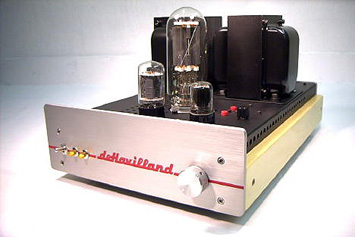
The deHavilland Aries 845 Monoblock
DAVID ROBINSON'S SYSTEM: LOUDSPEAKERS ELECTRONICS SOURCES CABLES ACCESSORIES
|
Introduction
You know, Georgie K. and Kara C. make a very righteous amplifier… and Dr. Kevin B. has a speaker that compliments it right well. But I’m getting ahead of myself...
Having moved back and forth between the world of high current (Linn Klimax at 500 WPC) and flea-powered (the SET/SACD project of a couple of years ago), I was interested in listening to something that would be in-between… more than 4 Watts, but less than 80-100. (I’m reserving that range for a hoped-for project involving Joule Electra and Merlin.) Keeping my eyes/ears open while at CES 2001, I dropped in on my audio friends George Kielcynski ("the K!") and Kara Chaffee ("KC!"), whose 572-based amplifier had made such an impression on me the prior year.
I have really fond memories of that CES. I got to spend time with a number of good friends (George Cardas, Stan Ricker, Dave Glackin, Steve Hoffman, Jim Ricketts, Brian Morris, etc., etc., etc.), heard some great systems that sounded good even under show conditions (hard to do, that), and had some decent food and drink. Unfortunately, my trusty digital camera was having technical problems at the last minute, so didn’t make the trek with me—bloody thing—but I did take along a set of reference SACDs as consolation.
One of the truly musical rooms that my SACDs and I visited was the deHavilland/Buggtussel suite. Quoting from my show notes (Positive Feedback, Vol. 9, No. 2):
Another great room for music and sound was the deHavilland / Buggtussel room. people like Kara Chaffee and George Kielczynski ("the K"!), together with Kevin Blair of "the Bugg company" made my visit there a helluva good time. I've was really impressed with the earlier deHavilland 572-based monoblocks-these are currently a Positive Feedback reference here in River City- and their new 845 blocks look terrific and sound exceptional. (Hope to get these in some day.) They were also equipped with an SACD player, which made it overwhelmingly tempting to whip out a couple of my favorite SACD's, especially given the somewhat staid music going on in many of the rooms. So on went both Oldfield's Tubular Bells and Spitball's hellaciously punchy alternative rock SACD, Pop Condition. Playing through some of the larger Buggtussel transmission lines, smashing good music was delivered. We proceeded to dance and boogie big time! (You know, Georgie K can really shake that thing!) The tandem of deHavilland electronics and the big Buggtussels made for a room filled with joyous noise... not to mention pulling in a number of GenX'ers who wanted to know, "What's that kewl music?!" Definitely scrumptious. Anyone wanting to check out some truly innovative tube gear should get in touch with deHavilland's designs at www.dehavillandhifi.com and Buggtussel at www.buggtussel.com ... definitely worth doing! A Ye Olde Editor's "very highly recommended!
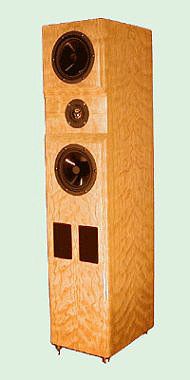
The Buggtussel Amygdala
In the aftermath of that terrific experience, I asked Georgie K. and KC to send a pair of the Aries 845’s to Portland to replace their SV572/KT-88-based amp. George was also kind enough to arrange with Dr. Kevin Blair of Buggtussel to send along a pair of the Amygdala, so that we could have a pair of moderately efficient (91dB/W/m) loudspeakers, and I could hear the amplifier in my listening room using similar transducers.
Technical Specifications
The deHavilland Aries 845 is a pure Class A component, featuring zero negative feedback. The input is a 6SN7, with a 6AV5 driver, feeding a Chinese 845 directly heated triode (DHT) output tube. The transformers are a set of hefty Electra-Prints; as was clear when I began to listen, Jack Elliano and company (www.electraprint.com) have not lost their touch. The finish is a kind of modern retro look—glass, metal, wood side plates, large switches and aluminum faceplate, with that startling cursive red logo—combining utility with a unique style. I have to say that I like the look of the deHavilland.
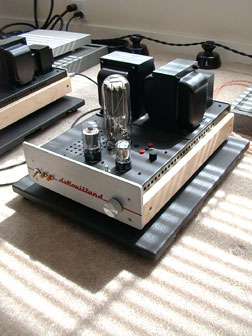
The deHavilland Aries 845 on a
The claimed power rating of the Aries 845 is 25 Watts into 8 Ohms, which is less than the rated 40 WPC of the Aries 572. The amp measures 12" wide by 18" long by 10" high, and weighs in at a respectable 57 pounds. (Complete technical specifications can be found at www.dehavillandhifi.com/aries845.htm.)
Dr. Kevin Blair of Buggtussel is a very interesting fellow. The word that I heard is that Kevin is a medical doctor, with a powerful interest in the human brain, as well as audiophile speaker design. Thus we have a speaker line that uses names from the anatomical lexicon of res mentis. Intriguing!
The speaker that we received was the Amygdala, from roughly the mid-point of the Buggtussel line. The nominal frequency response is 32-22kHz, with a nominal impedance of 6 Ohms, and a rated sensitivity of 91dB/W/m. The drivers are comprised of a 1" Aual tweeter, and two 7" Kevlar mid/bass units crossovered at 3kHz. The Amygdala is 47" high by 10.5" wide by 19.5" deep, and weighs in at 90.5 pounds. The review pair were finished in the natural oak. Other finishes are available from Buggtussel. (More complete technical specifications and the design philosophy are to be found a (www.buggtussel.com/amygdala.html and www.buggtussel.com/technical.asp.)
The Amygdala speakers are transmission lines, though with some modifications that Blair claims get it past some of the problems of such designs. I’ve always enjoyed TL’s myself, but do find that they can be problematic for placement, and for balance in a given room. A simple rule: if you need bass reinforcement, move carefully towards the walls; if you need to reduce the bass, move carefully away from them. (This is harder to get right than it seems, by the way.)
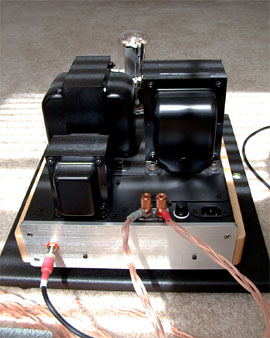
Ancillary equipment included the Sony SCD-1 SACD player, the Linn CD-12 CD transport, the Linn LP-12/Ekos/Arkiv II/Lingo/Linto/Cirkus turntable system, the Audio Research Reference Two, Mark II preamp, JENA Labs SE interconnects and Trio speaker cables, and Cardas power cables. (For more details, see my PF Online system description at www.positive-feedback.com/staff.htm.)
The Amygdala were given a light (approximately 7.5 degree) toe-in, and were kept about 3-4 feet out from the side walls, and about the same from the back wall. Your mileage will vary, no doubt; expect to expend some elbow grease and time to get the soundstaging, imaging, lower frequencies and tonal range correct in your room.
The Sound
I have listened to other 845 amplifiers in my listening room, though of a radically different character. The Bel Canto SET-80’s were a dual 845 setup producing up to about 80 WPC. We had them here in River City for quite a while, and found them to be extraordinary amplifiers at first listen. I paired them with my reference Nova Rendition II loudspeakers, and at first was drawn right in. The sound was big, musical, golden, and very seductive, truly a fine experience.
Over time, though, I found that the "goldenness" of the sound became perhaps a bit predictable, as though this implementation of the 845’s was oriented toward the stereotypically euphonic. Not tubby; not rolled off; just "golden," all the time.
It’s hard to express this strange response… because I’ve heard all sorts of tube amplifiers that escape the labels and categories of the past generation. Indeed, it’s meaningless to use the term "tube-like" any more—there’s no such creature!
Perhaps a different room; perhaps different speakers; perhaps cabling… who knows? Bel Canto makes fine products; I’m sure that someone else could have made such promising amplifiers sing!
What I knew was that the 845 tube hadn’t quite succeeded in their first pass in my listening room. Would the deHavilland Aries 845/Buggtussel Amygdala do any better?
Setting up the Aires 845 is very straightforward. I placed them on isolation stands between the speakers, put on my cotton gloves, installed the three tubes, wired the amps to the speakers (following the deHavilland instructions step-by-step all the way), then got out my trusty Rat Shack digital multi-meter. I followed the recommended procedure for dialing in the bias, which is extremely simple to do. Within a few minutes, I was ready to go.
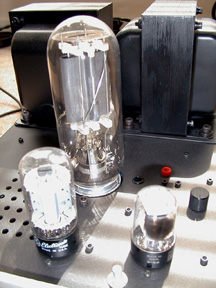
When I first fired up the amplifiers, I was pleased with the relatively low noise floor. This can be a problem with some tube amplifiers, but is not with the Electra-Print equipped Aries 845. Like the earlier 572 model, it is a quiet creature; a very gentle buzz at the speaker, a little white noise, inaudible at normal listening distances, is all that’s there. Another good feature of the 845 is its "soft start" power-up, giving the tubes a few seconds to get on track before going live.
(A word to the wise: Based on my experience, I would allow these amps about 30 minutes to warm-up before doing any "deep listening." They’re not bad…don’t leave them on full-time… but keep the lead time in mind before doing any really important listening session.)
The 845 for review has the attenuators, allowing the listener to use the amplifier directly from a source should that be desired. I’d recommend this option if you can afford it; it’s very helpful to be able to dial in the output of the amplifier, or use it without a preamp at need. Me, I generally kept the output turned up to 3:00 or so—I like the joint to jump at need!
Unlike my earlier 845 experience, this combination delivered what I remembered from CES: a clear, clean sound… articulate and nicely detailed… without the overdose of "golden" that happened (to my dismay) in my room before. It was a relief to sit back and enjoy what I was hearing.
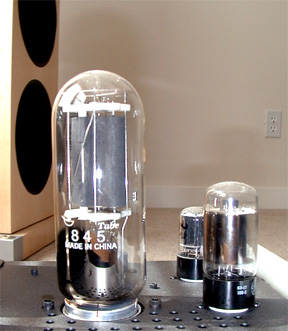
Those who know the magic of DHT’s and the 845 know where the utter magic of this tube is: the midrange of the Aries 845 glorious! Right now I’m listening to the exceptional new SACD from Sony/Columbia, James Taylor’s JT. This SACD arrived just recently, and both Brian Moura and I are agreed that it’s wonderful! (If you don’t have it yet… get it. "Don’t think twice, it’s alright…") Taylor’s voice is smashing… I keep wandering away from the keyboard… just to hear this recording sound better than I’ve ever heard it. Ditto on the new Lauryn Hill Unplugged SACD (magic!!); ditto again on Winston Ma’s utter reference SACD River of Sorrow—acoustical instruments and the human voice are rendered with an ease and naturalness that rests and heals your spirit.
The Aries 845/Amygdala do this without rolling off the upper frequencies, though; extension and the sense of air and space, which is what LPs and SACDs deliver so superbly, is present in proper proportions. Percussives are natural and quick; the metal domes that Buggtussel uses in its 1" dome don’t "spit," or become harsh/aggressive. State-of-the-art SACDs/LP playback make this a particularly important consideration; this combination does not disappoint. The presentation is quick, spacious, and lithe—very appealing, indeed.
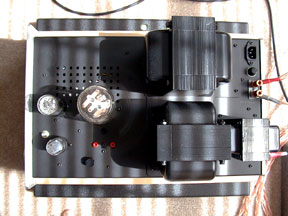
I adjudge the bass to be quite good. The Amygdala is not going to deliver the basement octave (18-36 Hz) the same way that the Linn Komri does, nor even reach the respectable 25 Hz that the Nova Rendition II delivers with such beauty, but what it does produce is clean and controlled. The Aries 845 has no problems with anything other than the most demanding bass recordings (you will definitely lose the bottom register of Spitball’s Pop Condition SACD or Joe Satriani’s Engines of Creation… then again, those are pretty unusual recordings! I reckon that pipe organ aficionados… well, that suffering group always has a problem with this….)
The dynamics of the presentation are good, though probably more pleasing to "microdynamicists" than "macrodynamicists." Soundstaging, with proper setup (lightly toed-in to taste), is very good. The presentation is not as wide as the Komri or Nova Rendition II’s, but depth front-to-back is clean and well-rendered. Imaging is not as precise as with the Linn Komri/Klimax; then again, that’s not a fair match, eh?
Are there any drawbacks? Since nothing’s perfect, the answer is "of course." The Aries 845/Amygdala will do a better job on jazz or chamber orchestras or human voice/acoustic instruments than with the Rolling Stones on SACD (oh YEAH!), though the presentation of driving rock and roll will probably not suffice for those who prefer high current/lower efficiency designs. (Make sure that you don’t live in an apartment building, though!)
Then again… I’m listening to the brand new ABKCO SACD reissue of the Rolling Stones Flowers over the Aries 845/Amygdala… "Lady Jane" is sounding so bloody fine, that I can’t sit in my chair and write about it without jumping up from time to time to sit in the listening room—just down the hall—to take it all in. These SACDs are sine qua non for anyone with the good sense to have an SACD player, and who loves great music. I guess that I’d have to say that rockers/rollers should not be frightened off… that last octave can only be delivered by a handful of systems on the planet, anyway. The Aries 845/Amygdala deliver an awful lot of pure musical joy!
I should also note that the efficiency of the Amygdalas, while decent at 91dB/W/m, is only middle of the efficiency pack. The Aries 845 has enough power to drive this speaker, but I wouldn’t want to use too much less than this with the Amygdala. Those with low-powered/flea-powered SETs will need more efficiency in a speaker.
Over a number of months, I’ve put quite a few SACDs, LPs and CDs through this combination, and I have to say that the Aries 845/Amygdala is an absolutely delightful tandem. Always musical, but never sentimental, this tandem pleased me at all times. If you’re looking for the magic of DHT’s with some additional horsepower, and a speaker that complements the sound very nicely, you should definitely put this pair on your audition list.
The deHavilland Aries 845/Buggtussel Amygdala combination therefore rates a Ye Olde Editor’s "very highly recommended."
Manufacturers:
deHavilland Electric Amplifier Company
TEL: 925. 837. 7201
email address: [email protected]
web address: www.dehavillandhifi.com
Current pricing: deHavilland Aries 845 is $6000/pair, with several custom options (Elma custom stepped attenuators @ $600; Cardas Gold/Rhodium binding posts @ $200) available. Call or email for details.
Buggtussel, LLC
TEL: 269. 321. 9660
web address: www.buggtussel.com
Current pricing: $4000/pair in natural oak, as of our last information. Contact Buggtussel for current pricing/availability.
